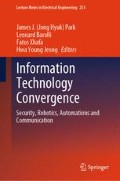Abstract
We describe here a marker tracking algorithm for indirect positioning during planar fabric manipulation. Indirect positioning is a unique problem during manipulations of deformable objects. Improving the tracking of position by a robotic system contributes to the dexterous manipulation of deformable objects. To formulate this algorithm, we assessed the movement of a single robotic finger moving one manipulated point on a fabric to one positioned point or marker, to the desired point on a floor. To select an appropriate algorithm, we classified disturbances during the positioning of fabrics. To precisely detect the position of the marker during these disturbances, we applied the combination of a particle filter and a labeling processing to the algorithm. Experimental evidence showed that, due to its precision in detecting position, this algorithm was suitable for indirect positioning.
Access this chapter
Tax calculation will be finalised at checkout
Purchases are for personal use only
References
Taylor PM (1990) Sensory robotics for the handling of limp materials. Springer Verlag, Berlin
Taylor PM, Pollet DM, Abbott PJW (1998) The Influence of environmental conditions on automated fabric handling. J Rob Mechatron 10(3):258–263
Parker JK, Dubey R, Paul FW, Becker RJ (1983) Robotic fabric handling for automation garment manufacturing. J Eng Ind 105:21–26
Fahantidis N, Doulgeri Z (2000) A gripper for grasping non-rigid material pieces out of a bundle. In: Proceedings of the IEEE international conference on intelligent robots and systems, pp 2145–2150
Kabaya T, Kakikura M (1998) Service robot for housekeeping? Clothing handling? J Rob Mechatron 10(3):252–257
Torgerson E, Paul FW (1987) Vision guided robotic fabric manipulation for apparel manufacturing. In: Proceedings of 1987 IEEE international conference on robotics and automation, pp 1196–1202
Ono E, Kita N, Sakane S (1995) Strategy for unfolding a fabric piece by cooperative sensing of touch and vision. In: Proceedings of the IEEE international conference on intelligent robots and systems, pp 441–445
Hirai S, Wada T (2000) Indirect simultaneous positioning of deformable objects with multi pinching fingers based on uncertain model. Robotica 18(1):3–11
Kita Y, Saito F, Kita N (2004) A deformable model driven visual method for handling clothes. In: Proceedings of the international conference on robotics and automation, pp 3889–3895
Paraschidis K, Fahantidis N, Vassiliadis V, Petridis V, Doulgeri Z, Petrou L, Hasapis G (1995) A robotic system for handling textile materials. In: Proceedings of 1995 IEEE international conference on robotics and automation, pp 1769–1774
Hamajima K, Kakikura M (1998) Planning strategy for task untangling laundry? Isolating clothes from a washed mass? J Rob Mechatron 10(3):244–251
Hata S, Hojoh H, Toda M, Hamada T (2011) Cloth handling system for linen supply industry. In: Proceedings of the international conference on mechatronics and automation, pp 864–869
Shibata M, Ota T, Endo Y, Hirai S (2008) Handling of hemmed fabrics by a single-armed robot. In: Proceedings of the 4th IEEE conference on automation science and engineering, pp 882–887
Shibata M, Ota T, Hirai S (2009) Wiping motion for deformable object handling. In: Proceedings of the IEEE international conference on robotics and automation, pp 134–139
Shibata M, Ohta T, Hirai S (2010) Robotic unfolding of hemmed fabric using pinching slip motion. In: Proceedings of the international conference on advanced mechatronics, pp 392–397
Shibata M, Hirai S (2012) A fabric manipulation utilizing contacts with environments. In: Proceedings of the IEEE conference on automation science and engineering, pp 438–443
Smith RS, Cheng-Chih C, Fanson JL (1994) The design of hinf controllers for an experimental non-collocated flexible structure problem. IEEE Trans Control Syst Technol 2(2):101–109
Matsuno F, Ohno T, Orlov YV (2002) Proportional derivative and strain (PDS) boundary feedback control of a flexible space structure with a closed-loop chain mechanism. Automatica 38(7):1201–1211
Shibata M, Hirai S (2006) Soft object manipulation by simultaneous control of motion and deformation. In: Proceedings of the 2006 IEEE international conference on robotics and automation, pp 2460–2465
Isard M, Blake A (1998) Condensation-conditional density propagation for visual tracking. Int J Comput Vis 29(1):5–29
Burger W, Burge MJ (2007) Digital image processing: an algorithmic introduction using java. Springer
Acknowledgments
This research was partially supported by The Furukawa Foundation for promotion of technical science.
Author information
Authors and Affiliations
Corresponding author
Editor information
Editors and Affiliations
Rights and permissions
Copyright information
© 2013 Springer Science+Business Media Dordrecht
About this paper
Cite this paper
Shibata, M. (2013). Marker Tracking for Indirect Positioning During Fabric Manipulation. In: Park, J., Barolli, L., Xhafa, F., Jeong, HY. (eds) Information Technology Convergence. Lecture Notes in Electrical Engineering, vol 253. Springer, Dordrecht. https://doi.org/10.1007/978-94-007-6996-0_93
Download citation
DOI: https://doi.org/10.1007/978-94-007-6996-0_93
Published:
Publisher Name: Springer, Dordrecht
Print ISBN: 978-94-007-6995-3
Online ISBN: 978-94-007-6996-0
eBook Packages: EngineeringEngineering (R0)

